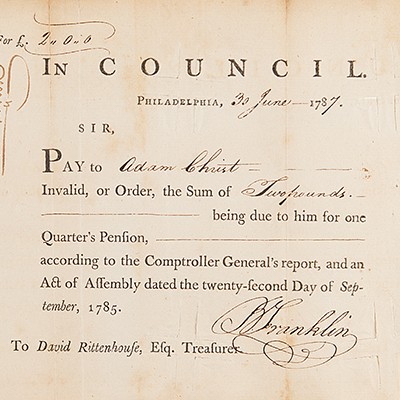Marie Curie Typed Letter Signed from the Radium Institute - offering her condolences on the passing of a radiochemistry pioneer
Two ways to bid:
- Leave a max absentee bid and the platform will bid on your behalf up to your maximum bid during the live auction.
- Bid live during the auction and your bids will be submitted real-time to the auctioneer.
Bid Increments
| Price | Bid Increment |
|---|---|
| $0 | $5 |
| $50 | $10 |
| $200 | $25 |
| $500 | $50 |
About Auction
Jan 10, 2024
RR Auction support@rrauction.com
- Lot Description
TLS signed “M. Curie,” one page, 5.5 x 8.5, Science Faculty at the University of Paris (Radium Institute) letterhead, September 15, 1927. Letter to physicist Alois Francis Kovarik, a professor in the Sloane Laboratory at Yale University, in full (translated): “I have just received your letter about Professor Boltwood, whose sad end I was completely unaware of. I thank you very sincerely for the kind thought that you have written to me to inform me of the circumstances in which this misfortune occurred. Please believe that I feel very keenly the loss of such a distinguished scholar and that I realize how particularly sensitive this loss is for Yale University and for yourself. My daughter joins me in expressing her regrets. Please accept, Dear Sir, the assurance of my distinguished feelings.” Matted with a small portrait and the original mailing envelope to an overall size of 21 x 17.25. In fine condition.
Bertram Borden Boltwood (1870-1927) was a pioneer of radiochemistry from New England, who attended Yale University, became a professor there, and in 1910 was appointed chair of the first academic department of radiochemistry. He established that lead was the final decay product of uranium, noted that the lead-uranium ratio was greater in older rocks, and, acting on a suggestion by Ernest Rutherford, was the first to measure the age of rocks by the decay of uranium to lead, in 1907. His work with the uranium decay series led to the discovery of the parent of radium, a new element that he named ionium. However, once the existence of isotopes was established, ionium was in actuality thorium-230. Although Boltwood did not get his element on the periodic table, he later got a mineral namesake: Boltwoodite is named after him. In his later days, Boltwood suffered from depression and committed suicide on August 15, 1927.
A colleague of Bertram B. Boltwood, Alois Francis Kovarik (1880-1965) was a professor of physics at Yale University, who was among the first scientists to gauge the age of the Earth through the ‘radioactivity clock method.’ In 1930, speaking before the Connecticut Academy of Arts and Sciences, he gave his estimate of the minimum age of the Earth to be 1,852,000,000 years, based on his study of the disintegration of uranium into lead. He also studied the ionization of gases and Alpha, Beta, and Gamma rays. During World War II, he was one of the nuclear scientists assembled for work on the atomic bomb project. - Shipping Info
-
Bidder is liable for shipping and handling and providing accurate information as to shipping or delivery locations and arranging for such. RR Auction is unable to combine purchases from other auctions or affiliates into one package for shipping purposes. Lots won will be shipped in a commercially reasonable time after payment in good funds for the merchandise and the shipping fees are received or credit extended, except when third-party shipment occurs. Bidder agrees that service and handling charges related to shipping items which are not pre-paid may be charged to a credit card on file with RR Auction. Successful international Bidders shall provide written shipping instructions, including specified Customs declarations, to RR Auction for any lots to be delivered outside of the United States. NOTE: Declaration value shall be the item’(s) hammer price and RR Auction shall use the correct harmonized code for the lot. Domestic Bidders on lots designated for third-party shipment must designate the common carrier, accept risk of loss, and prepay shipping costs.
-
- Buyer's Premium



 EUR
EUR CAD
CAD AUD
AUD GBP
GBP MXN
MXN HKD
HKD CNY
CNY MYR
MYR SEK
SEK SGD
SGD CHF
CHF THB
THB





